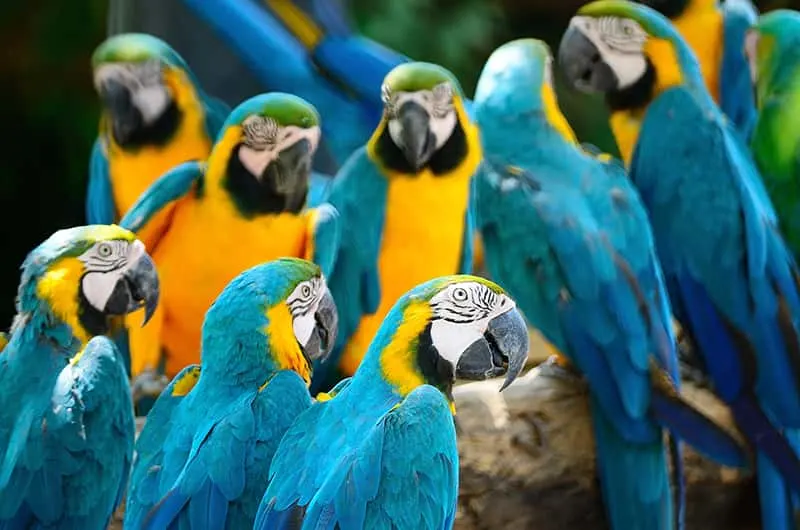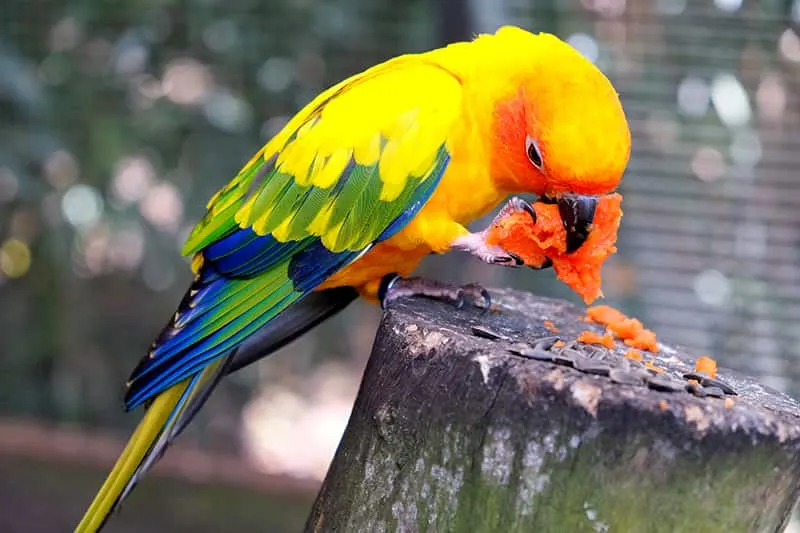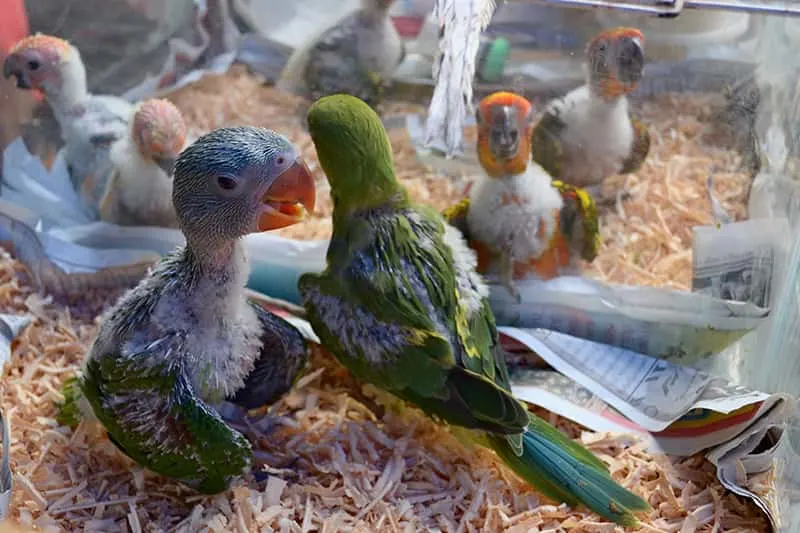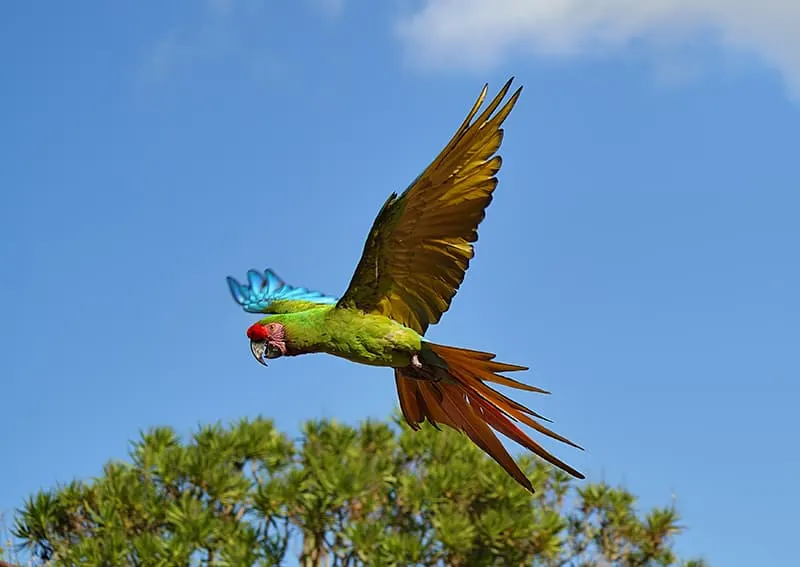Do you want to learn some interesting facts about parrots? You’ll learn all about them in this post. We’ll discuss their physical description, diet, offspring, and more!

Physical Description
Parrots have curved beaks and sturdy bodies. They are noted for having zygodactyl feet. Their feet have two toes that point forward and two toes that point backward.
Parrots can have long or short tails. Most parrots have brightly colored feathers. Their plumage is typically a mix of greens, blues, yellows, and reds. There are also parrots that have gray or black feathers.
Parrots range from three and a half inches to forty inches in length. They weigh anywhere from three ounces to nine pounds.
Habitat
Parrots can be found in many regions worldwide. They are found in Africa, South America, Central America, India, Southeast Asia, South Asia, Oceania, and Australia. While most parrots are found in tropical locations, three species can be found in snowy, alpine areas.
Most parrots live and nest in trees. If their habitat doesn’t contain trees, they use rocky outcrops, termite mounds, or cacti as nesting sites.

Habits
Parrots are social creatures and live in flocks. Parrot flock sizes range anywhere from twenty birds to thousands of birds. Living in a flock helps parrots defend themselves from predators. The more parrots there are, the more difficult it is for a predator to attack just one of them.
Parrots do most activities as a group. They travel, eat, play, and roost together. Parrots are known for being excellent communicators. They communicate with their eyes, their bodies, and by making sounds.
A flock of parrots is a big group of chatterboxes because they are always “talking” to each other. Parrots talk by making a variety of different sounds. Squawks, calls, whistles, and chirps are just some of the noises parrots make to talk to other flock members.
Diet

Parrots are omnivores. Most species of parrot eat a variety of foods, but seeds are their favorite. Parrots eat a range of nuts, seeds, flowers, fruit, and insects. Only a few parrot species eat nectar as their primary source of nutrition. Parrots get the water they need from their food.
Offspring
A female parrot lays two to eight eggs at a time. Parrot parents take turns sitting on the eggs. The eggs can take up to thirty days to hatch. When the chicks hatch, they are blind and have a thin layer of downy feathers.
Both parents help take care of the chicks. While the father goes foraging for food, the mother stays with the chicks.
A month after hatching, the chicks’ eyes open, and their adult feathers have grown in. At about two months old, the chicks begin to practice flying and forage for food.
Parrots begin to teach their young parrot chicks the skills they will need as they mature. Other flock members also help teach the juvenile parrots. Adults teach the juvenile parrots skills such as how to use a warning call when a predator approaches or how to find water.
The time it takes for a juvenile parrot to become fully independent ranges from two months to fourteen months. The time it takes for parrots to mature into adults ranges from one to four years.

Classification/Taxonomy
Kingdom: Animalia
Phylum: Chordata
Class: Aves
Order: Psittaciformes
Family: Psittacidae
Genus: More than 60 genera
Species: More than 350 species
History
The Therapod dinosaur family were the ancestors of parrots. These dinosaurs roamed the Earth two hundred million years ago. The parrot species first appeared fifty-nine million years ago. Scientists believe that parrots first evolved in the region of Australia.
Predators
Parrots spend most of their time in trees, so they are rarely threatened by land animals. Raptors like hawks and eagles are the most common natural predators of parrots. Monkeys, snakes, and bats are some of the other animals that prey on parrots.
Lifespan
Wild parrots have a lifespan of about sixty years. In captivity, some species of parrots have been known to live for more than a hundred years.

What Sound Does a Parrot Make?
To hear what a parrot sounds like, click on this audio file.
25+ Unusual Parrot Facts
- A group of parrots is called a “pandemonium”.
- Some parrot species mate for life.
- Parrot flocks split into smaller groups to perform activities such as foraging for food or guarding against predators.
- The larger the parrot species is, the longer it lives.
- Parrots are often called “hookbills” because of their strong hooked beaks.
- Parrots use their beaks to crack open nuts and seeds, as well as to climb and defend themselves.
- Parrots are known for being able to repeat words and sounds they hear around them.
- Over 50 species of parrot are considered endangered.
- There are roughly 20 million parrots kept as pets in the US.
- Pet parrots imitate human speech because they see their owner as part of their flock.
- Most parrots taste food with the top of their beaks rather than with their tongues.
- Puck the parakeet holds the record for the largest vocabulary of any bird, with 1728 words.
- Charlie the Macaw, who was 114 years old in 2022, is the oldest parrot on record.
- The Thick-billed parrot is the only remaining species of parrot that is native to North America.
- Almost one-third of all parrot species are threatened by habitat loss and the pet trade.
- There are 3 superfamilies of parrots: true parrots, cockatoos, and New Zealand parrots.
- Parrots use their toes to help them climb and grasp objects such as food.
- Parrots have the ability to fly up to thirty miles every day.
- Swift parrots and orange-bellied parrots are the only parrots that migrate each year.
- Most parrots fly between 40 and 50 miles per hour.
- In the United States, there are over 50 species of feral parrots.
- Parrots can recognize images and sounds much faster than humans do.
- Parrots make excellent pets, but they require a lot of attention and care.
- Parrots are the only birds that can use their feet to bring food up to their beaks to eat.
- Even though parrots copy human words, they don’t always understand what the words mean.
- When parrots sleep, they stand on one foot.
- The Australian Night Parrot is so elusive it has only been spotted three times.
- Alex, the African Grey parrot, was believed to be as smart as a five-year-old kid.
- Male and female parrots look almost identical to each other.
- Most parrots are active during the day and sleep about twelve hours a night.
- Parrots typically stay within a few acres of their home range but will fly many miles to find food.
- Wild parrots bath in rain, waterfalls, streams, and small pools of water.
- Parrots cannot swim.
We hope you enjoy learning all about parrots! Did you learn anything new? Let us know any other facts you know about them. We can’t wait to hear more.
You don't want to miss learning about these cool birds.
